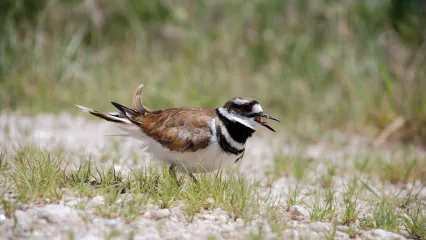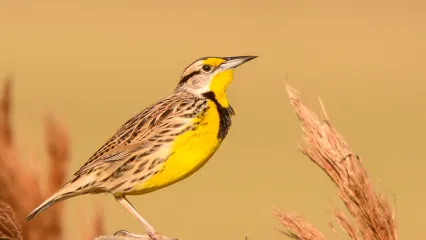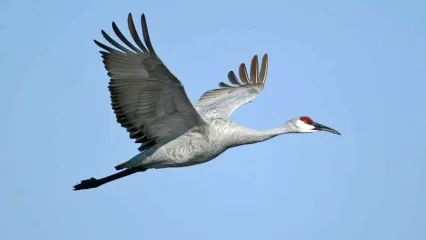
Description
One of the few birds that sounds like it is saying its names when calling, the killdeer (Charadrius vociftrous) is an entertaining bird to watch for its interesting call and quirky antics.
Its call sounds like a very high pitch, nasally wail of "kill-dee! Kill-dee! " or a shorter "Kee! Kee! Kee!" They are one of the most successful of all shorebirds due to their fondness for human-modified habitats and willingness to live very close to people. Often found in dry, flat landscapes, the killdeer can be seen around pond shores, sandbars, mudflats, and grazed fields; however, they can also be found at parks in cities and on lawns, driveways, graveled parking lots, athletic fields, and golf courses or flat graveled rooftops.
A member of the plover and lapwing group of shorebirds, the killdeer is a medium-sized bird about the size of an American robin and is often described as lanky in body shape and taller than many other plovers with longer wings and tails. The species is easily identified by its two striking black neck bands that encircle the neck onto the upper breast of white while the rest of the body is a drab brownish-tan with a white belly. Distinct markings also include a large white patch on the face between the bird's large eyes and a bright orange-colored tail seen only when in flight or while displaying.
While searching for food, killdeer will run a short distance, stop and bob their body, flashing their white throat at the same time, and then rise up to check their surroundings before running another short distance and repeating. The act of flashing the white on their throats is thought to startle invertebrates into moving, allowing the bird to see it and quickly jab at it for a quick meal. Killdeer mainly eat invertebrates such as worms, snails, grasshoppers, beetles, ants, aquatic insect larvae, and crayfish. Killdeer commonly follow farmers as they plow their fields in hopes of finding freshly unearthed worms or insect larvae. They will also eat seeds from agricultural fields or even hunt small frogs and small minnows found along the shore of a lake or pond. Killdeer are a beneficial species to have around because their diet can serve as a form of pest control.
If disturbed, the bird will first run away. If the pursuit continues, it will fly up and circle overhead, calling repeatedly and loudly. If a curious and harmless intruder comes near, killdeer might "gang up" on the intruder and make a significant amount of noise and fly closely until the intruder leaves for a less disruptive place.
Killdeer uses a "broken wing" display that makes them appear hurt or injured to draw intruders away from their nest to protect their eggs or young from predation. They are not the only species to use this technique, but they are best known for it. The adult will act like their wing is broken and will flail on the ground, hopefully drawing the intruder away while running away themselves when approached too closely.
Size
Killdeer are 59-63 cm in size.
Habitat
The killdeer can be either a resident or a medium distance migrant. Some northern breeding birds will migrate to and winter in Mexico while others that live in the southern half of the United States tend to be year-round residents. Killdeer generally start arriving at their nesting grounds in early March.
Life Cycle
Killdeer will pair up and stay together for a few years, producing one to three broods of young each breeding season. They lay two to four eggs per clutch in a nest that is often a simple scratched out depression in the ground that the adult will add materials too after laying the eggs. The eggs are speckled in brown, tan and black to blend into the substrate of the ground and be camouflaged from predators.
After incubating for 22-28 days, the chicks hatch in the order they were laid. The young chicks are fully covered in downy feathers upon hatching and are out of the nest as soon as they are dry to start searching for food with their parents. Young killdeer have stilt-like legs and are very fuzzy, with white bellies and brown and black mottling on their back and head to help camouflage them when hiding from danger. The chicks also have a single black neck-ring that will turn into two rings once their juvenile plumage grows in at 17 days of age. Killdeer have been known to live up to 10 years.



